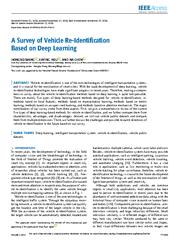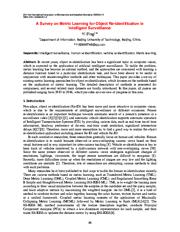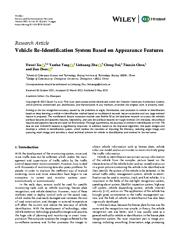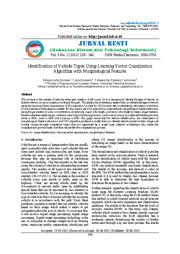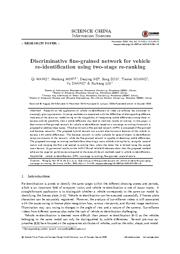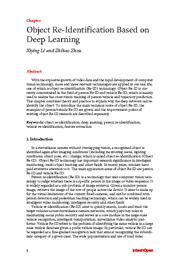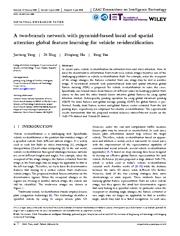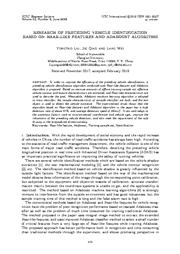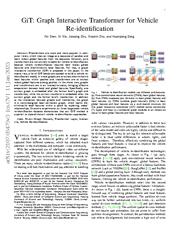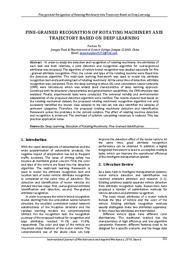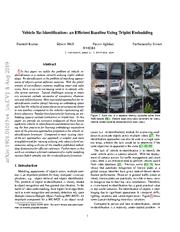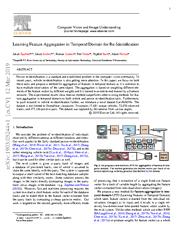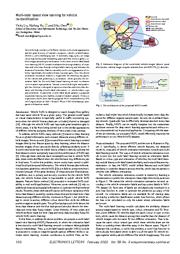A copy of this work was available on the public web and has been preserved in the Wayback Machine. The capture dates from 2021; you can also visit the original URL.
The file type is application/pdf.
Filters
A Survey of Vehicle Re-identification Based on Deep Learning
2019
IEEE Access
There are mainly five types of deep learning-based methods designed for vehicle re-identification, i.e. methods based on local features, methods based on representation learning, methods based on metric ...
Therefore, making a comprehensive survey about the vehicle re-identification methods based on deep learning is quite indispensable. ...
As a result, vehicle re-identification methods based on deep learning become a research hot spot in recent years.
1) VEHICLE RE-IDENTIFICATION METHODS BASED ON LOCAL FEATURES Due to deep learning and ...
doi:10.1109/access.2019.2956172
fatcat:gxzry6py4bhrjnb2qxqtu4r27u
A Survey on Metric Learning for Object Re-identification in Intelligent Surveillance
2017
DEStech Transactions on Engineering and Technology Research
This paper provides a survey of existing metric learning approaches for object re-identification, which focuses on the methods based on the application of metric learning. ...
To tackle the problem, metric learning has become an optimal method, and the approaches are concerned with learning a distance function tuned to a particular identification task, and have been shown to ...
Based on these data, the vehicle re-identification can effectively improve the accuracy of vehicle identification, especially for the buses [8] . ...
doi:10.12783/dtetr/ismii2017/16644
fatcat:j4ocgyrsnbfjdkha7bv4uvr2xy
Vehicle Re-Identification System Based on Appearance Features
2022
Security and Communication Networks
Aiming at the low recognition accuracy caused by the problems of angle, illumination, and occlusion in vehicle re-identification based on deep learning, a vehicle re-identification method based on multibranch ...
On this basis, the attribute features and apparent features are fused for fine retrieval. ...
Preliminaries
Vehicle Re-Identification Based on Deep Learning. ...
doi:10.1155/2022/1833362
fatcat:rfvknzlrcvd6heacrfbpa5nv24
Identification of Vehicle Types Using Learning Vector Quantization Algorithm with Morphological Features
2022
Jurnal RESTI (Rekayasa Sistem dan Teknologi Informasi)
This paper shows that for vehicle identification, the combination of morphological feature extraction and LVQ algorithm produces a model that can identify vehicles based on their shape and classify classes ...
This study aims to develop a system that can identify the type of vehicle using the Learning Vector Quantization (LVQ) algorithm. ...
Acknowledgment The researcher would like to thank the LPPM of the Universitas Teknokrat Indonesia for the Internal Grant and the Universitas Teknokrat Indonesia which has provided support and funding for ...
doi:10.29207/resti.v6i2.3954
fatcat:ykg2xxflmndkddqceucmmrg6zq
Discriminative fine-grained network for vehicle re-identification using two-stage re-ranking
2020
Science China Information Sciences
In this paper, a discriminative fine-grained network for vehicle re-identification based on a two-stage re-ranking framework is proposed to address these issues. ...
Research on the application of vehicle re-identification to video surveillance has attracted increasingly growing attention. ...
[26] , we apply the compact bilinear pooling method to obtain finegrained features based on the previous vehicle re-identification effort. ...
doi:10.1007/s11432-019-2811-8
fatcat:ffarwzdodjee3iixpgrsatkt5q
Discriminative Feature and Dictionary Learning with Part-aware Model for Vehicle Re-identification
[article]
2020
arXiv
pre-print
of vehicle re-identification. ...
TCPM base on part discovery is that partitions the vehicle from horizontal and vertical directions to strengthen the details of the vehicle and reinforce the internal consistency of the parts. ...
[21] proposed a vehicle reidentification method based on the region of interest, which combined the ROI local features into a structural feature for vehicle re-identification tasks. Wang et al. ...
arXiv:2003.07139v1
fatcat:unyauudzsjcqxog2tlmw3d632m
Object Re-Identification Based on Deep Learning
[chapter]
2019
Visual Object Tracking in the Deep Neural Networks Era [Working Title]
With the explosive growth of video data and the rapid development of computer vision technology, more and more relevant technologies are applied in our real life, one of which is object re-identification ...
Object Re-ID is currently concentrated in the field of person Re-ID and vehicle Re-ID, which is mainly used to realize the cross-vision tracking of person/vehicle and trajectory prediction. ...
Vehicle Re-ID We will review the relevant works of vehicle Re-ID from three aspects: vehicle re-identification based on artificial design feature, vehicle re-identification based on deep learning feature ...
doi:10.5772/intechopen.86564
fatcat:uzv4zeatp5a4hayryjwgtzu2o4
A two‐branch network with pyramid‐based local and spatial attention global feature learning for vehicle re‐identification
2021
CAAI Transactions on Intelligence Technology
A two-branch network with pyramid-based local and spatial attention global feature learning (PSA) is proposed for vehicle re-identification to solve this issue. ...
How to learn the discriminative information from multi-view vehicle images becomes one of the challenging problems in vehicle re-identification field. ...
This pyramid-based local feature learning branch can capture part-level feature information with different scales on the one hand. ...
doi:10.1049/cit2.12001
fatcat:xyr5uyh4wbdpzn2gvo3ikkjowu
Research of Preceding Vehicle Identification Based on Haar-Like Features and Adaboost Algorithm
2018
ICIC Express Letters
Based on massive amounts of offline training sample set, effective vehicle contour and texture characteristics are extracted, and Haar-like characteristics are used to describe the goal. ...
In order to improve the efficiency of the preceding vehicle identification, a preceding vehicle identification algorithm combined with Haar-like features and Adaboost algorithm is proposed. ...
This work is partially supported by the Fundamental Research Funds for the Central Universities in China (No. 310822171116 and No. 310822171001). ...
doi:10.24507/icicel.12.06.575
fatcat:cz672dogfbbqbkrvc4msrck3du
VEHICLE DETECTION AND IDENTIFICATION WITH SMALL DATASET USING FEW-SHOT LEARNING
2023
International journal of advances in signal and image sciences
However, most deep learning methods for vehicle detection rely on large number of datasets for the training to perform well. ...
A detection method that could adapt with small samples could be a powerful solution for this problem. One of the popular methods is the Few-Shot Learning (FSL) algorithm. ...
The meta-learning processes extract the meta-feature of each sample to be learned by the model, it is also employing feature reweighting to adjust its weight for the best possible outcome. ...
doi:10.29284/ijasis.9.2.2023.55-66
fatcat:fw4tyg4xpvc6djbbdlaad53gee
GiT: Graph Interactive Transformer for Vehicle Re-identification
[article]
2023
arXiv
pre-print
However, pure transformers are not entirely suitable for vehicle re-identification because vehicle re-identification requires both robust global features and discriminative local features. ...
Extensive experiments on three large-scale vehicle re-identification datasets demonstrate that our GiT method is superior to state-of-the-art vehicle re-identification approaches. ...
As shown in Fig. 1 (b), based on CNNs, there is a straightforward way of combining global features and local features learned from vehicle image partitions. ...
arXiv:2107.05475v3
fatcat:clvlgvnd4vgz3adokovnkvwy7a
FINE-GRAINED RECOGNITION OF ROTATING MACHINERY AXIS TRAJECTORY BASED ON DEEP LEARNING
2019
International Journal of Mechatronics and Applied Mechanics
The results showed that based on the rotating mechanical dataset, the proposed rotating machinery recognition algorithm not only accurately identified the known class samples in the test set, but also ...
The algorithm of vehicle brand recognition was studied especially for fine -grained attribute recognition. First, the colour and type of the rotating machine were fused into the detection algorithm. ...
However, different features need to be designed for a specific scenario, and the image data
Fine-grained Recognition of Rotating Machinery Axis Trajectory Based on Deep Learning processed in the data ...
doi:10.17683/ijomam.issue5.31
fatcat:yvcqs6vanvccdjhknourrz3jwa
Vehicle Re-Identification: an Efficient Baseline Using Triplet Embedding
[article]
2019
arXiv
pre-print
Most successful approaches for re-identification involve (deep) learning an embedding space such that the vehicles of same identities are projected closer to one another, compared to the vehicles representing ...
In this paper we provide an extensive evaluation of these losses applied to vehicle re-identification and demonstrate that using the best practices for learning embeddings outperform most of the previous ...
vehicle embedding based on training a network for vehicle-model classification task. ...
arXiv:1901.01015v4
fatcat:5d4u4aykyzfg5gnjh3nhpygidm
Learning Feature Aggregation in Temporal Domain for Re-Identification
[article]
2019
arXiv
pre-print
The experimental results show that our method outperforms other existing methods for feature aggregation in temporal domain on both vehicle and person re-identification tasks. ...
The aggregation is based on weighting different elements of the feature vectors by different weights and it is trained in an end-to-end manner by a Siamese network. ...
We focus on appearance-based vehicle re-identification: vehicles' license plates were only used for ground truth data acquisition (recorded by a zoomed-in camera). ...
arXiv:1903.05244v1
fatcat:bjps7atu3rcgdimob7s45uyvia
Multi‐label based view learning for vehicle re‐identification
2021
Electronics Letters
First, the vehicle orientation estimation module is responsible for detecting key-points of the vehicle and predicting its orientation, which provides the orientation label for the multi-label based learning ...
features caused by multi-view appearances of vehicles. ...
,Liu, B., et al.: Multi-labelbased similarity learning for vehicle re-identification. ...
doi:10.1049/ell2.12377
fatcat:xaza3qt6ivcwzlznrevuy73oju
« Previous
Showing results 1 — 15 out of 98,490 results

